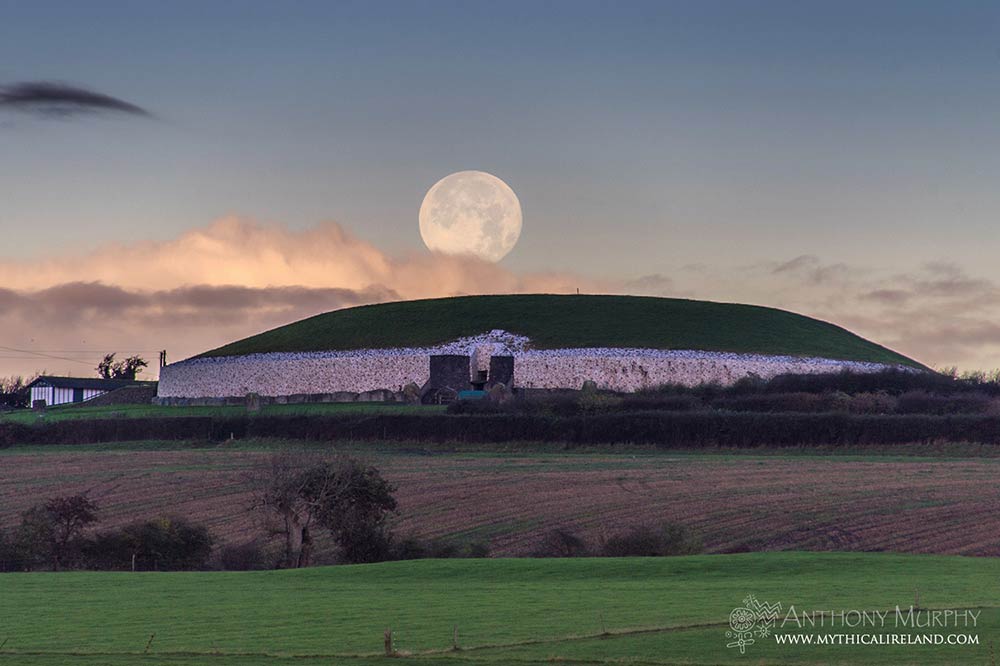
How the Moon’s 19-year Metonic Cycle could have been observed in Neolithic Ireland
Why was the moon important to prehistoric people like those who built the great Stone Age monuments of the Boyne Valley?
Was it even important at all?
Even today, I suspect a majority of people know that the moon moves through phases, sometimes appearing as a crescent, sometimes as a ‘half-moon’ (what astronomers call a quarter moon because we are seeing on quarter of its total surface area illuminated; we never see its back side!) and sometimes a full moon. Do most people know or recognise the fact that the moon disappears from our skies for three days every month?

The first crescent 'new moon' above the Hill of Slane in the Boyne Valley.
I doubt it. We have lost touch with the moon, so to speak. We have calendars and watches and clocks and all manner of computers and smartphones and similar digital technology that tell what time of the day it is, what the date is and what year it is. Many people in the 21st century have lost interest in the moon as a time-keeper.
In pre-modern, pre-literate, and prehistoric societies, the moon was absolutely crucial for keeping time, and for the maintenance of a practical calendar. No pre-modern society could effectively keep track of calendrical time without it.
There is a significant emphasis in modern academia (in the fields of archaeoastronomy, archaeology and anthropology in particular) about the all-encompassing significance of the sun and its regulation of the seasons. This is somewhat understandable, given that in Ireland in particular, and many parts of the globe where agriculture was practiced in ancient times, the sun could either help or hinder the production of agricultural goods. The people who built the great Brú na Bóinne monuments of Newgrange, Knowth and Dowth, for instance, were among Ireland’s early farmers. Crop and animal husbandry had been introduced here around 6,000 years ago, in approximately 4000BCE.
The superbly skilled alignment of the passage and chamber of Newgrange (anciently called Síd in Broga in mythological texts) towards the rising sun on the shortest days of the year, centred on winter solstice, indicates the presence in the Neolithic of a culture clearly interested in the sky. In midwinter, the light of the rising sun enters the monument through a specially constructed aperture (called the ‘roof box’ by archaeologists) and penetrates the long passageway, entering the chamber, where a thin pencil of light (maximum 17cm wide) shines brilliantly upon the floor of its corbel-vaulted chamber, which is otherwise in darkness for the rest of the year.

The passage and chamber of Newgrange are precisely designed to allow the light of winter solstice sun shine into the chamber.
Recent studies indicate that the sun actually reaches the chamber of Newgrange for 18 days either side of solstice,[1] meaning firstly that sunlight can be seen in the chamber for more than a month, for 36 days, and secondly that daily observations of that phenomena allow for a careful study of what we might call the ‘standstill of the sun’. The sun on its own (i.e. without any study or observations of the moon) allows for only a very basic calendar, since the sun only offers two ‘visual cues’ during the year – the summer and winter solstices. These are the only times when the sun’s position on the horizon at sunrise and sunset come to a halt. At all other times, the sun’s horizon position is on the move from day to day. A purely solar calendar has two ‘hooks’, from which all the days in between must be counted in order to determine other significant dates in the calendar – such as determining the right times to sow and harvest crops, the correct times to depart home to make the journey to Newgrange and other monuments at certain key points of the calendar and predicting the annual migrations of birds and other creatures in and out of the Boyne Valley (for instance the whooper swans and Atlantic salmon).
Without the moon, your calendar only consists of solar days and solar years. Every important date for agriculture and ritual celebration must be counted from the last solstice. And given that the solstices are more than 180 days apart, this is hardly practical.
The moon, however, despite its many wanderings, follows monthly patterns that give you a much more convenient system of counting days, weeks and months. In fact, the moon is truly the origin of our whole notion of months. The very word ‘month’ derives from Proto-Germanic and Proto-Indo-European roots for the words ‘moon’ and ‘to measure’.[2]
There are different types of lunar months, which have varying lengths, one of the factors leading some modern scholars to doubt whether prehistoric minds could figure out its apparently complex movements, but we’ll get to some of that discussion shortly. For now, let’s keep things simple.
The most obvious lunar movements are those in which the moon appears to complete a circuit of the sky (the sun takes a year (365.24 days) to move through the entire zodiac or the ‘ecliptic’, the astronomical term for the imaginary path of the sun through the sky; the moon completes a circuit of the sky in just over 27 days (27.321661 days to be precise), and the one in which the moon goes through its phases – starting with first crescent, then first quarter (half moon), then full, then last quarter, then last crescent, and finally the moon appears to disappear for three days. There are daily changes in the moon’s shape between these distinct phases, such that it is constantly either waxing (growing) or waning (contracting) in size. Confusingly, modern astronomy uses the term ‘new moon’ for what should really be called ‘invisible moon’ or ‘dark moon’. It seems much more convenient to use the term ‘new moon’ for the first appearance of the slender crescent moon in the west after sunset, following its three-day disappearance. For the purpose of keeping things simple, I will use that terminology, ‘invisible moon’, in place of ‘new moon’ and ‘new moon’ interchangeable with ‘waxing crescent’ or ‘first crescent’. For the same reason of simplicity, I will use the term ‘first half’ moon in place of ‘first quarter’.
The two lunar months mentioned above are known as the sidereal month and the synodic month. In layman’s terms, the sidereal month is the length of time it takes the moon to return to the same background stars. In other words, if you see the moon under the Pleiades star cluster tonight, then regardless of its phase/shape, it will return to that position beneath the Seven Sisters in 27.3 days. The synodic month is the length of time it takes the moon to re-attain the same shape. So for instance, if you see a full moon tonight, you will see the next full moon in 29.531 days. Thankfully, for the purposes of maintaining a lunar calendar, you do not need to know the length of the lunar month to three decimal places. And nor did the people who built the Neolithic monuments of Brú na Bóinne.
Difference in lunar months
Immediately we are presented with an apparent dichotomy. The time it takes the moon to complete a circuit of the sky (sidereal month) and the time it takes the moon to return to the same phase (i.e. first crescent to first crescent, full moon to full moon, last half to last half) differ by over two days. This is not the major quandary it appears to be, and is certainly not a barrier to the study of lunar patterns in prehistoric culture. Bear with me.
The reason for the difference in these two lunar months is obvious to modern astronomers. In the time it takes the moon to return to the same background stars, the earth has moved approximately one-twelfth of the way around its orbit of the sun. Since the full moon is always opposite the sun in the sky (the observant among you will have noticed that the full moon usually rises around the time of sunset and sets around the time of sunrise), it takes a little bit longer for the moon to return to the same phase because of the intervening movement of the earth around the sun. In everyday language, the full moon ‘lines up with’ the earth and sun. At full moon, the sun, earth and moon are positioned such that you could draw an imaginary straight line between them.
The difference between the length of the sidereal month and the synodic month is something that must have been noticed to any human who could count, or even merely observe, in pre-modern times. But this is the least of the moon’s complexities, as we shall see, and it matters little in the keeping of lunar time because it is likely that early peoples reckoned lunar time by the moon’s phases – which, constantly changing, allow time to be measured in small quantities or time periods such as, for instance, a week (seven nights) between first half and full moon, and a week between full moon and last half.
Lunar and solar year not the same
At some time in the remote past, possibly tens of thousands of years ago or longer, it became apparent that the ‘lunar year’ – i.e. a certain number of full moons, either 12 or 13 – was not the same as a ‘solar year’. The solar year becomes apparent through the solstices, those times when the sun is standing still, offering a visual indication of the marking of solar time. Early people may not have known precisely that the length of the year was 365.24 days. However, in the passage-tomb culture of the Irish Neolithic, where some monuments (such as Cairn T at Slieve na Calliagh, Loughcrew) were oriented towards the sunrises at equinox, they probably did notice that every year at equinox the sun appeared to move very slightly compared to the previous year, and that every four years the sun appeared to ‘jump back’ a small amount in the sky on the same date, meaning that once every four years the equinox would be a ‘day late’, so to speak, because of the accumulation of those four quarter days that make up the modern extra day in a 366-day leap year. Without the leap year, our modern calendar would drift out of synch and eventually Christmas would be in mid-June! The equinox effect is explained in this brief video.
The fact that the lunar ‘year’ and the solar year are not the same length appears to be a troublesome problem. And indeed it is, but only to an extent. It would be a beautiful synchronisation of nature if the moon and sun moved completely in time with each other and, for instance, the full moon occurred on the date of winter solstice every year. But that is not what happens. One of the results of the difference in the length of the lunar and solar years is the changing date of Easter in the Christian calendar every year. Easter is celebrated on the first Sunday after the first full moon following vernal equinox. Because the number of lunations or synodic periods does not fit neatly into a 365.24-day sun year, the full moon after spring equinox does not occur on the same date each year.
If you were to undertake a rudimentary study of the ‘lunar year’ (I’m putting the term in inverted commas because we do not recognise, in modern times, the concept of a lunar year because our calendar is based on the solar year), and count 12 synodic months – i.e. if you were to begin your count at full moon and then watch and count 12 full moons after that, you will find that 29.5 days (the synodic month) multiplied by 12 equals 354 days.
In other words, a lunar year of 12 full moons is shy of a solar year by around 11 days. The lack of synchronisation of the lunar and solar year presents us with both a problem and an opportunity. The problem is that a full moon on, say, vernal equinox, will not be repeated the following year. A year later, the full moon will occur 11 days before vernal equinox. The opportunity is to attempt to reconcile the solar and lunar periods, or at least to see if it is possible to do so. And it is! But again, bear with me.
Below is a short video demonstrating how you can witness the disparity between the lunar year and the solar year by watching a full moon and then counting 12 full moons from that date, taking careful note of the date on which you observed the first full moon. You will notice that the 12th full moon after you saw the first one occurs 11 days BEFORE the same date on the next calendar year.
Time immemorial
The difference between the length of the solar year and the lunar year as defined by the number of lunations or synodic months has been known and recognised since antiquity, if in fact it has not been acknowledged since time immemorial.
The problem of 12 synodic months being shy of a solar year by 11 days was not an insurmountable one. That’s because anyone who kept a record of solar years, synodic months and ‘differential’ days (i.e. the difference between the solar year and a given number of synodic months in days plus/minus the solar year) would be able, in time, to discern an extraordinary pattern in the apparent dissonance of the solar and lunar cycles. Every so often, they do resynchronise.
Let’s demonstrate how. For the sake of argument, let us assume a Stone Age astronomer standing at Síd in Broga (Newgrange) is aware that the solar year lasts 365 days, and has counted the number of days between solstices. (This is not as easy as it sounds, mainly because as the sun ‘stands still’ on the horizon for several days, it is not always easy to discern the exact day of solstice, and also because weather often inhibits the observation of the light beam phenomenon inside the monument’s chamber. Furthermore, it is likely that the moon was used to help calculate the exact date of solstice, but I’m getting a bit ahead of myself here!)
For the purpose of convenience, let us assume that our observer at Newgrange witnessed a full moon occurring on the exact day (the evening, obviously, for the full moon appears when the sun sets) of winter solstice.
Year 1
Now let's move forward in time by 12 full moons. Since last solstice, when the moon happened to be full, he has counted 12 full moons and found that the last of those 12 full moons occurred a whole 11 days before this winter solstice. Let’s call this Year 1 of his observations. The sun had already begun shining into Newgrange when he observed that twelfth full moon, and had been for a week, but it would be 11 more days before the sun reached the middle of its standstill point.
Year 2
Now let’s suppose he continues the count. The following year (Year 2), he finds that on the day of the 24th full moon (i.e. another 12 full moons later), the full moon occurs 22 days before winter solstice, four days before the light of the morning sun will enter the chamber of Newgrange.
Knowing that the synodic month is around 29 months long, our Stone Age astronomer realises that counting an extra full moon might help. Instead of 24 full moons being shy of the second winter solstice by 22 days, he finds that 25 full moons is about eight days past winter solstice, and thus occurs when the sun is still shining into the chamber of Newgrange in the mornings. (It is eight rather than seven days over because of the cumulative effect of the half-day of the 29.5-day synodic month).
Year 3
In year three, he continues to count full moons as they occur. The day of the twelfth full moon of Year 3 (37 synodic months in total, because he has added the latest 12 full moons to the 25 that brought him eight days beyond last winter solstice) occurs just THREE days short of the winter solstice, when the sunrise is shining brilliantly into the chamber of Newgrange and the sun is reaching its period of standstill.
Year 4
In year four, he counts another 12 full moons, and that twelfth full moon (the 49th full moon since he began counting at the beginning of Year 1) occurs 14 days short of winter solstice. Why 14 days short? Well, remember that 12 full moons is 11 days shy of winter solstice. So if last year’s 37th full moon was three days short of winter solstice, it stands to reason that the 49th full moon will be 14 days short.
Year 5
In Year 5, after counting another dozen full moons, he finds the day of the 12th full moon of that year (61st full moon since he began counting) is 25 days short of winter solstice. To keep things as closely synchronised as possible, he must add an extra moon in Year 5 (a ‘Leap’ Moon, so to speak), bringing the 62nd full moon just five days after winter solstice.
His exercise in counting is both fascinating and frustrating. When, he wonders, will the full moon occur on the day of winter solstice again? It is now five years since he witnessed the full moon rising on the evening of winter solstice, and he may well be wondering when, and if, the full moon will coincide with winter solstice again.
Not to be deterred, he keeps watching and counting full moons (synodic months) to determine whether his hope of seeing a full moon at winter solstice will ever be realised.
A full 18 years of counting is represented in the table below.
|
Year
|
Full moons
|
Days +/- a year
|
Leap year
|
|
|
|
|
|
|
1
|
12
|
-11
|
|
|
2
|
25
|
8
|
YES
|
|
3
|
37
|
-3
|
|
|
4
|
49
|
-14
|
|
|
5
|
62
|
5
|
YES
|
|
6
|
74
|
-6
|
|
|
7
|
87
|
13
|
YES
|
|
8
|
99
|
2
|
|
|
9
|
111
|
-9
|
|
|
10
|
124
|
9
|
YES
|
|
11
|
136
|
-2
|
|
|
12
|
148
|
-13
|
|
|
13
|
161
|
6
|
YES
|
|
14
|
173
|
-5
|
|
|
15
|
186
|
14
|
YES
|
|
16
|
198
|
3
|
|
|
17
|
210
|
-8
|
|
|
18
|
223
|
11
|
YES
|
At first glance, this calculation of full moons seems convoluted. Let us simplify it a bit. In column one are the number of solar years in the count. In column two are the total number of synodic months or full moons he has counted since that day when full moon first coincided with the day of winter solstice. In column three are the differential days, i.e. the number of days the full moon in column two occurs before or after winter solstice of the year given in column one. The fourth column indicates the lunar ‘leap year’, i.e. whether an additional or 13th full moon was added to reduce the number of differential days.
It is important to point out at this juncture that the counting of full moons does not need to begin at winter solstice. This count can be commenced on any day of any year, because the pattern is repeating and the result will be the same.
Leap moons
We can see that a total of seven additional full moons (leap moons) have been added to reduce the differential days figure in each of those years. The early Christian church called these ‘intercalary’ moons. The addition of a 13th moon is carried out every two or three years, in this sequence: 2, 3, 2, 3, 3, 2, 3.
At no point in this 18-year period does the number of full moons exactly equal the length of the solar year. We can see at Year 8 and at Year 11, the differential is just TWO DAYS. Close, but no cigar.
However, the eagle-eyed among you might have spotted something interesting about Year 18. The 223rd full moon of that year occurs 11 days after winter solstice. Given that 12 full moons is 11 days short of a year, i.e. 354 days, then we only have to add another 12 synodic months to bring us back to the very beginning of the cycle – on that day, the 235th full moon since counting began will occur exactly on winter solstice. Here is the complete table representing the synchronisation of the solar and lunar years:
|
Year
|
Full moons
|
Days +/- a year
|
Leap year
|
|
|
|
|
|
|
1
|
12
|
-11
|
|
|
2
|
25
|
8
|
YES
|
|
3
|
37
|
-3
|
|
|
4
|
49
|
-14
|
|
|
5
|
62
|
5
|
YES
|
|
6
|
74
|
-6
|
|
|
7
|
87
|
13
|
YES
|
|
8
|
99
|
2
|
|
|
9
|
111
|
-9
|
|
|
10
|
124
|
9
|
YES
|
|
11
|
136
|
-2
|
|
|
12
|
148
|
-13
|
|
|
13
|
161
|
6
|
YES
|
|
14
|
173
|
-5
|
|
|
15
|
186
|
14
|
YES
|
|
16
|
198
|
3
|
|
|
17
|
210
|
-8
|
|
|
18
|
223
|
11
|
YES
|
|
19
|
235
|
0
|
|
The Metonic Cycle
We finally have the answer to the question ‘when will the full moon occur on winter solstice again?’ It will happen after 19 sun years have passed, or 235 full moons. This 19-year period is known today as the Metonic Cycle, and is named after the man who is given credit for its discovery. In the 5th century BCE, the Greek mathematician and astronomer Meton carried out calculations and is recognised as the one who ‘discovered’ the eponymous Metonic Cycle, the 19-year cycle in which the lunar and solar years are seen to synchronise.[3]
However, there is some reason to believe that the 19-year ‘Metonic’ Cycle was understood and recorded almost three millennia earlier, on a kerb stone at the Knowth monument which was constructed around 3300BCE.[4] A future article will examine exactly how this kerb stone – dubbed The Calendar Stone because of the claim that it contained ‘calendrical engravings’ by American artist and author Martin Brennan[5] – might have been used to calculate the Metonic Cycle.
Something else about the above table becomes apparent if we present the data in a slightly different way. Have a look at the table below and see if you can spot something fascinating about the arithmetic.
|
Year
|
Full moons
|
Days +/- a year
|
Leap year
|
Year
|
Full moons
|
Days +/- a year
|
Leap year
|
|
|
|
|
|
19
|
235
|
0
|
|
|
1
|
12
|
-11
|
|
18
|
223
|
11
|
YES
|
|
2
|
25
|
8
|
YES
|
17
|
210
|
-8
|
|
|
3
|
37
|
-3
|
|
16
|
198
|
3
|
|
|
4
|
49
|
-14
|
|
15
|
186
|
14
|
YES
|
|
5
|
62
|
5
|
YES
|
14
|
173
|
-5
|
|
|
6
|
74
|
-6
|
|
13
|
161
|
6
|
YES
|
|
7
|
87
|
13
|
YES
|
12
|
148
|
-13
|
|
|
8
|
99
|
2
|
|
11
|
136
|
-2
|
|
|
9
|
111
|
-9
|
|
10
|
124
|
9
|
YES
|
Why have I laid it out in this way, you might ask. Well, it’s because of an interesting quirk of nature that shows us how the entire 19-year Metonic Cycle might have been predicted ahead, into the future, thereby allowing our Neolithic observer to work out in advance the answer to his question: ‘when will the full moon occur on winter solstice again?’ The explicit suggestion here is that the synchronisation of the full moon count with the solar year could be seen to occur at 19 years, without the observer having to SEE or observe the entire 19-year cycle.
Have a look at any row, and add the years in the year columns, and you will get 19 years. Add the two ‘full moons’ figures in any row and you will get 235, the number of full moons in a 19-year Metonic Cycle. Then take a look at the differential days – in any given row from years 1 and 18 down to years 9 and 10, and you will see that the differential day values cancel each other out. For each plus (+) figure, there is a corresponding minus (-) figure.
Let’s take the row with Year 5 and Year 14 as an example:
|
Year
|
Full moons
|
Days +/- a year
|
Leap year
|
Year
|
Full moons
|
Days +/- a year
|
Leap year
|
|
5
|
62
|
5
|
YES
|
14
|
173
|
-5
|
|
If you add the two Year values, 5 plus 14, you get 19, the end/beginning of the cycle.
If you add the full moons – 62 and 173 – you will get 235, the total number of synodic lunar months (full moons) that brings the cycle to an end and also a beginning.
If you take the differential days, 5 and minus 5, you get zero. Simply adding the figures in the corresponding column groups will give you the values of a complete Metonic Cycle.
19 years equals to 235 full moons with no days short or surplus.
Take another row as an example:
|
Year
|
Full moons
|
Days +/- a year
|
Leap year
|
Year
|
Full moons
|
Days +/- a year
|
Leap year
|
|
9
|
111
|
-9
|
|
10
|
124
|
9
|
YES
|
Add the Year values, 9 plus 10, and you get 19 years.
Add the full moons – 111 and 124 – and you get 235 synodic months, a complete cycle.
Minus 9 differential days plus nine differential days is zero.
Sidereal months
Another incredible facet of the Metonic Cycle is that once you count the years and the synodic months, the number of sidereal lunar months (the return of the moon to the same background stars) in any given year of the cycle can be worked out very easily.
To find out how many sidereal months there are in any given solar year, all you need to do is add the Year number to the Full Moons number! See the table below which shows how easy it is to calculate the number of sidereal months in any given year of the Metonic Cycle.
|
Year
|
Full moons
|
Sidereal months
|
|
|
|
|
|
1
|
12
|
1+12 = 13
|
|
2
|
25
|
2+25 = 27
|
|
3
|
37
|
3+37 = 40
|
|
4
|
49
|
4+49 = 53
|
|
5
|
62
|
5+62 = 67
|
|
6
|
74
|
6+74 = 80
|
|
7
|
87
|
7+87 = 94
|
|
8
|
99
|
8+99 = 107
|
|
9
|
111
|
9+111 = 120
|
|
10
|
124
|
10+124 = 134
|
|
11
|
136
|
11+136 = 147
|
|
12
|
148
|
12+148 = 160
|
|
13
|
161
|
13+161 = 174
|
|
14
|
173
|
14+173 = 187
|
|
15
|
186
|
15+186 = 201
|
|
16
|
198
|
16+198 = 214
|
|
17
|
210
|
17+210 = 227
|
|
18
|
223
|
18+223 = 241
|
|
19
|
235
|
19+235 = 254
|
The sidereal month value for 19 years is interesting. There are 254 sidereal lunar months in a Metonic Cycle. The original number of kerb stones at Knowth was 127. (Three are now missing, making the modern total 124). That number – 127 – is exactly half the number of sidereal lunar months in a Metonic Cycle. In other words, if you count each kerb stone at Knowth as a sidereal month, and make two circuits of the monument, you will have counted an entire Metonic Cycle! Coincidence? Perhaps.
‘Seeing’ the Metonic Cycle
In addition to the fact that the 19-year Metonic Cycle harmonizes or synchronises the solar and lunar year, there is a visual cue too. The Metonic Cycle places the same phase of the moon back in the exact same location against the background stars.
Say, for instance, you see the moon very close to the Pleiades star cluster in Taurus. Using Stellarium, and based on my location in Drogheda, Ireland, I see that the 82.1% illuminated waxing gibbous moon is in front of the Pleiades in the early morning of 10th January 2025, at 2.30am. In fact, it is occulting (blocking) some of the stars of the Pleiades. Now, when will I see that exact phase of the moon (waxing gibbous) in front of the Pleiades again?
The answer is in one Metonic Cycle’s time, or 19 years into the future. Yes, the moon will pass the Pleiades every month, but because of the difference in the length of the sidereal month (which brings the moon back to the same background stars) and the synodic month (which brings the moon back to the same phase), we will see a different phase of the moon passing the Pleiades from month to month, and even from year to year.
Another quirk in the moon’s journey through the sky is that it does not follow the same path as the sun, the one we call the Ecliptic. The moon’s path is actually inclined to the Ecliptic by 5.15 degrees, meaning that it wanders slightly north and slightly south of the Ecliptic, spending half a sidereal month north of it and half south, and intersecting it twice during each circuit. The points where the moon’s orbit crosses the Ecliptic are known as the lunar nodes, and these points rotate westwards over a period of 18.6 years. This is known as the rotation of the nodes, and it is because of this movement of the nodes that eclipses occur. But that will be the subject of a future article and videos and is beyond the scope of this current article, which I think you’ll agree is already complex and lengthy enough!
Conclusion and acknowledgements
The above article is based on instruction given to me in the year 2000 by Charlie Scribner, a retired medical doctor from Connecticut, US, who had studied lunar movements over many years and figured out the patterns of its behaviour. I do not know if Charlie is still alive and have not heard from him in many years. I still have some of the emails he sent me back then, along with other information he posted on the now defunct Irish-Stones Yahoo Group, which formed the basis of my own long study of this subject. It is clear to me now that Charlie was a savant. Reading his emails and all the figures and periods he presented makes my head spin even today! I am grateful to him for teaching me something that was not published in ANY modern astronomy textbook – how to look at the moon without binoculars or a telescope and see how it moves the way the people of the Neolithic saw it. The moon moves in predictable, repeating patterns. Any notion that the people of Stone Age Ireland did not possess the intellectual capacity to make observations and calculations relating to the moon’s movements is merely modern arrogance. They could figure it out, and if Martin Brennan’s interpretation of kerb stone 52 at Knowth is correct, they did figure it out. Keep an eye on the Mythical Ireland website for a future article and video about how the Calendar Stone could have been used to calculate the Metonic Cycle.
Anthony Murphy, March 2023
Footnotes and references
[1] Frank Prendergast, Clare Tuffy, Sinéad Gargan, John Lalor and Claire Breen, ‘Mapping the light fantastic at Newgrange’, Archaeology Ireland, winter 2021, pp. 30-35.
[2][2] https://www.etymonline.com/search?q=moon
[3] https://www.britannica.com/biography/Meton
[4] https://mythicalireland.com/blogs/ancient-sites/knowth-the-calendar-stone
[5] Martin Brennan (1983), The Stars and the Stones, Thames & Hudson, pp.144-5.

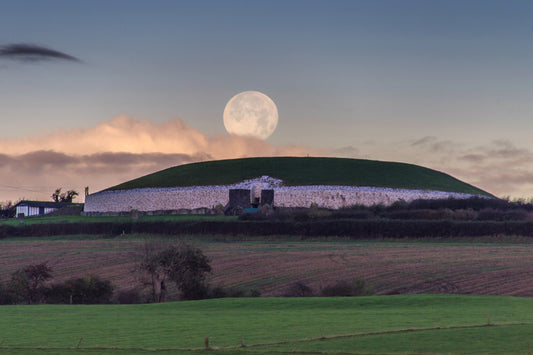
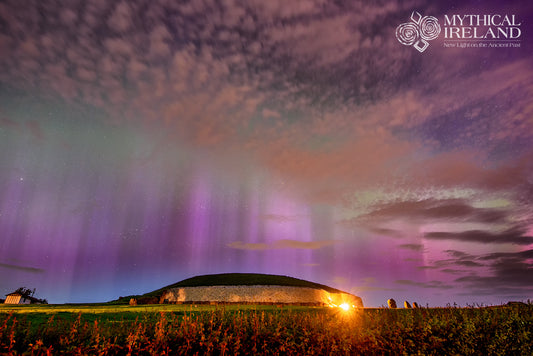

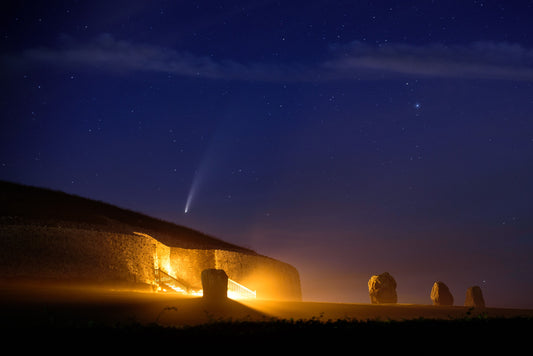
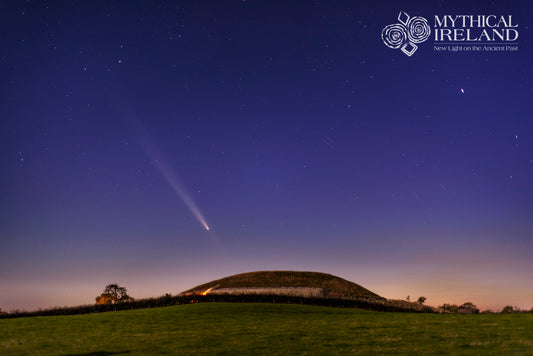
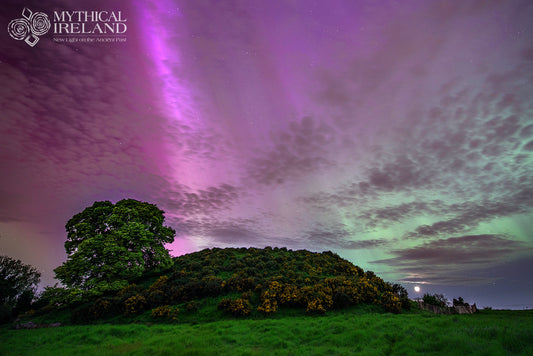
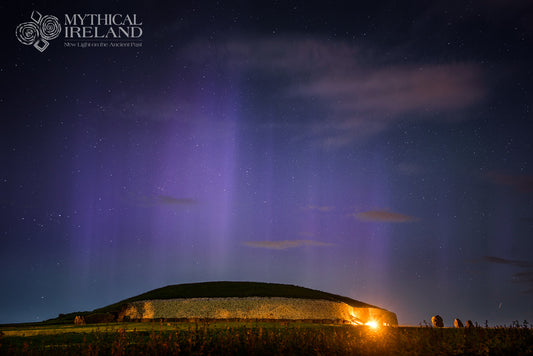
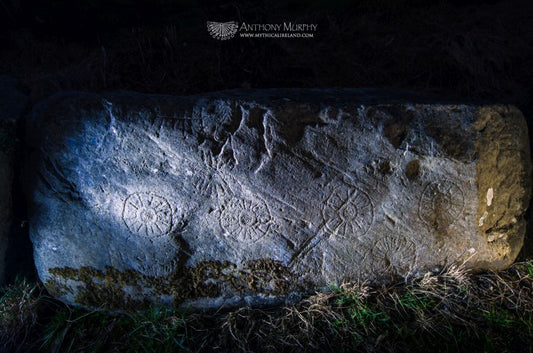
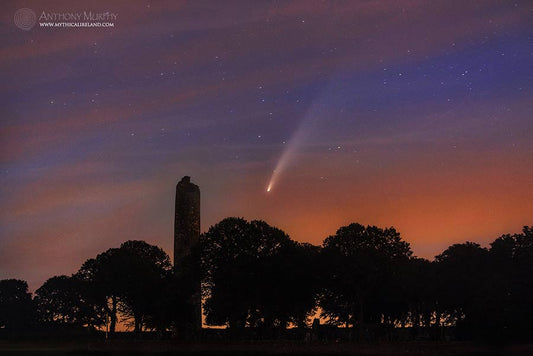
6 comments
I have no doubt humans have had knowledge of the Metonic Cycle for many thousands of years. Here in West Cornwall all the stone circles have 19 circumference stones. The stones in the middle of certain circle may be the Sun and the Moon stones.
We must remember that they did not just use this a calendric measurement of town. They WORSHIPPED this cycle,
https://adruidway.com/2018/01/16/nineteen-days-of-brighid/
“Among the traditions that have gathered around her is the significance of the number 19 — whether part of the ancient awareness of the moon’s Metonic cycle, or the Christian tradition for determining Easter, curiously associated with the full moon, or the 19 nuns at Kildare connected with Saint Brighid.”
Here in West Cornwall all our preserved stone circles have 19 stones around the circumference. Any middle stones could be depicting the Sun and Moon.
The circles are no doubt Metonic Temples. Humans worshipped the Heavenly bodies. The planets are named after gods and goddesses as well as the constellations. Once we actually believed they were god beings and we made sense of our lives and cycles by their movements.
The Metonic Cycle is still the most accurate way for humans to measure time, only a couple of hours out every 19 years where our Gregorian Calendar is a day out every four years.
“Although this 19-year cycle is usually called the Metonic cycle after Meton of Athens (432 BCE), the Babylonians used this cycle before Meton, and it may be that Meton learned of the cycle from the Babylonians.4”
https://mythicalireland.com/blogs/ancient-sites/knowth-the-calendar-stone
“And if we add 99 synodic months to 136 synodic months we reach the Metonic Cycle: 19 tropical years is equal to 235 synodic lunar months, or 254 tropical lunar months. A tropical lunar month is defined by the amount of time it takes the moon to reach the same background stars again – it is equal to 27.322 days.”
That was illuminating! (no pun intended). I have no doubts that ancestral people all over the world where not just knowledgeable about the Metonic cycle, but actually used it in ways we haven’t realized yet. The arrogance of modern man over ethnic cultures throughout the world has been a disservice to our understanding, as so many of these people passed the knowledge through storytelling and was discarded as fantasy by colonizers and such. Not to mention that without modern light pollution, all of this would have been more accessible to the naked eye. Your wonderful coherent explanation just further inculcates my fascination with cycles, astronomy and what it means to us. Thank you!
Thank you for your erudite explanation of these intertwining lunar and solar cycles. Is not the “jump back” you dramatically illustrated in the video on the leap year, not an artifact of the software program/calendar automatically jumping back 1 day on the leap year every 4 years?. Our neolithic ancestors I assume did not have “leap years” as such.
Wow, just wow! So interesting.. and so complicated.. my impression of our ancient ancestors has just been given a complete makeover. Thank you for introducing me to what could possibly be termed Druidic insight. The mind boggles at my celestial ignorance. Well done you. Brian
Hello Anthony! Barbara and I have been curious to determine the theme of each year in the 19 year cycle. In the "Song Of Amergin, " I think the theme might be in sets of three years, and I think it might have to do with metempsychosis. In “The Odyssey,” Odysseus’ 19 years has a lot to do with the goddesses. I’ve been thinking about all of this, and I’m glad to see you are, too.
On another note, I have just put out a second edition of our first book, “The Myth of the Year.” If I do an second edition of the third book, do you want me to include your essay on Venus?